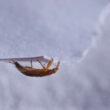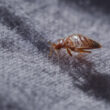“How many legs do cockroaches have?” is a question that’s commonly asked by homeowners who need help identifying these bugs.
This guide will answer this question and also give you some handy facts about cockroach legs. This will help you recognize them and better understand their behavior in your home.
Table of contents
How Many Legs Do Cockroaches Have?
Cockroaches have six legs. It can sometimes be difficult to see these legs, so if you come up short a leg or two, try looking again a little closer.
The reason it’s important to know this is because when many homeowners find these insects, they’re not completely sure how to identify them properly. For many, it’s the first time they’re seeing one cockroach in their house!
Quick Tip: Knowing how many legs a cockroach has won’t do all the work for you, but it will help you quickly confirm that your suspicions might be correct. After that, there’s a lot you can do to identify and determine the extent of the problem.
An Easy Way To Check
Before taking steps to deal with the cockroaches in your home, it’s necessary to determine if the bug you see is actually a cockroach. There are plenty of other beetles and bugs that look similar.
One of the easiest ways to capture a cockroach and count how many legs it has is by using a sticky pad that you place in their likely entryways. You can purchase these at your neighborhood retail store that sells bug control products.
Once you have your specimen, take some time to inspect the insect beginning with the number of legs that it has.
Other insects, like spiders, some ticks and scorpions, have eight legs and are termed an arachnoid. A spider will not have the telltale antennae that roaches and other insects do.
The roach is a member of the Blattodea species and will have six legs. The Latin word given to this insect is actually a good description of the bug. Blattodea means an insect that hides from the light. Of course, dark and out-of-the-way places are exactly where roaches hide.
Cockroach Leg Anatomy
Moving on, let’s discuss the specifics of the cockroach leg anatomy. Like all insects, a cockroach is divided into three different body parts. First is the head, and the head of a roach is smaller with a mouth pointing towards the ground.
Next there is the thorax or the midsection of the insect’s body. This thorax, or torso, is rather flat and shaped like an egg or oval. The last body part of the cockroach is the abdomen.
And here’s where the legs come in.
The cockroach has three different pairs of legs. All of the legs are located on the torso of the bug. Each of these leg pairs has a descriptive name, and there is a specific purpose for each pair of legs.

In general, a cockroach will have a shorter pair of front legs, a midsection set of middle legs and another pair of back legs. The bug uses these legs in different ways, and their unique ability to run so fast and to scurry across all different types of terrains is partly due to its leg properties.
The back legs of a cockroach will be somewhat longer and perhaps a smidge wider, and the insect uses those back legs to create propulsion and speed as it skittles along leaving their natural predators behind in their “smoke” so to speak.
Quick Tip: Cockroaches can use their legs to run at speeds of up to three miles an hour. That is an amazing feat for such a tiny creature.
A cockroach has thinner jointed legs that have spiny or spiky protrusions that have the purpose of gripping the surfaces better. This is the secret to why these insects can climb walls and walk across the ceiling turned upside down. Those spiky protrusions also help the bug sense where it is as it moves along.
The Purpose Of Each Pair Of Legs
Each pair of legs that the cockroach has attached to their midsection will serve a specific function.
Their pairs of legs are:
- Prothoracic – front legs
- Mesothoracic – middle legs
- Metathoracic – back legs
There are some practical and fun facts regarding each pair of cockroach legs. The jointed design, sticky capability protrusions, thin width of each leg, and larger hind legs give the cockroach the ability to dance around quite a bit.
The strong legs in the rear are used to forcefully propel the bug forward as it hops and runs. This is much like a trained dancer who uses certain leg poses to spring up in the desired direction during the choreographed routine.
1. Prothoracic Legs
The set of legs that sit directly behind the cockroach’s small head are known as the Prothoracic legs. Note that the legs are shorter than the rest. The insect uses these front legs to slow their movement down when the insect wants to stop running.
2. Mesothoracic Legs
The mesothoracic legs (or the center pair of legs) aid the bug by increasing or decreasing speed as needed.
3. Metathoracic Legs
Last, the larger hind legs of a roach are called the metathoracic legs. These appendages are mostly used for strong and powerful propel type movements. Scientists say that the cockroach can use its legs to propel itself forward at speeds and rates of 50 times its own body length in just a mere second.
Quick Tip: The cockroach has what is called cursorial legs. These legs are preferred for running purposes.
Why It’s Sometimes Hard to See All of Their Legs
Like their wings, these insects can fold up their legs underneath their body. This can make it a bit challenging to count how many legs a cockroach has.
On top of that, when these critters are scurrying around the floor it’s quite hard to see their legs. They move fast!
Another reason why it might be hard to see how many legs a cockroach has is because these insects can lose a leg (or a few) after getting in a fight or being preyed on. That means it’s not uncommon to see a cockroach missing a leg or two.
Quick Tip: This detail is important when trying to accurately identify the insect inside your home. It throws people off all the time!
Can They Survive When Missing Legs?
Yes, roaches are known to survive even when they lose legs. Usually, these bugs lose legs during a fight with a predator or other bug fighting for dominance. If a roach is scared enough, they will sometimes “drop” the leg being pulled. This enables them to make a speedy retreat to someplace safer.

This will sometimes leave behind a “nub” or stump of a leg at its upper end near the attachment to the thorax. You can use this to recognize that a leg would normally be there, making it easier for you to identify them.
Can They Regrow Their Legs?
Cockroaches have the ability to grow new legs in the event that they lose one(quite handy). This is actually a very common occurrence. The time these insects need in order to do this can vary depending on their size, species type, the nature of the missing leg, and the event that took place.
In general terms, cockroaches can regrow their missing legs in about five months if there is a “stump” left. Otherwise, the growing process will usually take a bit longer if the leg was yanked off in a traumatic manner. These cockroaches will likely only generate a portion of their regrown leg and it will often only be around one third of the size of the original one.
Conclusion
Now that you know how many legs cockroaches have, you should have an easier time identifying these household pests. While there’s more to it than simply counting their legs, it’s definitely a step in the right direction.
If you have any questions about cockroach legs or their anatomy just send us a message!


